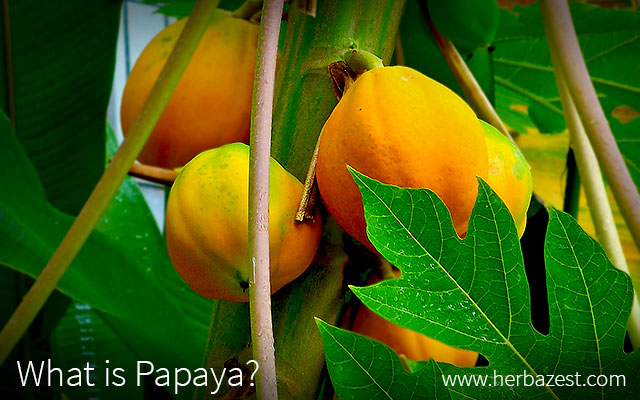Grown in tropical areas of the world, scientists define papaya as a member of the Caricaceae family, which is comprised of about six genera and 35 species. With sweet, nutritive fruits and powerful health-regulating enzymes, papaya has established itself as a unique species of both culinary and commercial importance.
About Papaya's Origins
Papaya origin remains unclear, but it is thought to be native to the tropical regions of the Americas, particularly southern Mexico and Central America. Gonzalo Oviedo's General and Natural History of the Indies (1526) is widely considered the first written papaya description and the earliest recorded account of papaya cultivation in Hispaniola, the Caribbean island presently shared by Haiti and the Dominican Republic.
Around that time, Portuguese and Spanish settlers began to trade papaya seeds, rapidly spreading them throughout the West Indies and much of South America. By 1550, papaya had reached the Philippines, India, and present-day Malaysia.
Traditional Papaya Uses
The culinary and medicinal uses of papaya, in the tropical areas where it naturally grows, have been part of traditional practices for centuries. The unripe, green papaya fruit produces a latex substance that contains an enzyme called papain. This white, viscous liquid has played a sizable role in the importance of papaya fruit in folk medicine, and it has popularly been applied to the skin for the removal of warts, boils, and freckles.
ALTHOUGH DEEMED A HAZARDOUS PRACTICE, PAPAYA SEEDS, LATEX, AND UNRIPE FLESH HAVE BEEN INGESTED IN ORDER TO RID THE BODY OF INTESTINAL PARASITES.
Meanwhile, in some parts of western Africa, infusions made from dried papaya leaf purportedly quiet stomach troubles and lower indigestion. They are also rolled and smoked to relieve asthma and other respiratory illnesses.
About the Papaya Plant
Papaya is a large herbaceous plant that grows up to 30 feet (9 m) tall and is known primarily for the economic and culinary importance of its fruits. Producing inconspicuous white, five-petaled flowers and a greenish-purplish stem that develops into a thick, trunk-like base, the plant is commonly referred to as papaya tree.
An unripe papaya fruit is mostly green, but its thin, durable skin gives way to a deep yellow or light orange color at full maturity. With black, ovoid seeds, fruits are melon-like, growing up to 20 inches (50 cm) long and weighing as much as 20 pounds (9 kg). Meanwhile, bright orange, or even reddish, the succulent pulp of a fresh, raw papaya has a sweet taste.
High above the fruits on the upper part of the stem, papaya leaves emerge in a spiral like an overhead canopy. As is the case with unripe papaya fruits, the leaves contain rich stores of the milky white latex papain.
Papaya Names
The language used to define papaya has a lot to do with why some people are still struggling to understand what a papaya is. Botanists, having studied the characteristics of papaya, have scientifically named it Carica papaya, being carica a Latin name that can be translated as "a kind of fig", in reference to its oval shape.
THE NAME OF PAPAYA IN ENGLISH IS OFTEN AND INCORRECTLY PRONOUNCED AS "PAW PAW," WHICH IS A SIMILAR-LOOKING FRUIT THAT ACTUALLY BELONGS TO A COMPLETELY DIFFERENT PLANT FAMILY.
Early European settlers aptly referred to papaya as "tree melon," and countless other iterations have developed as papaya became known throughout the world. Though papaya's etymology remains a mystery, it is widely believed to be an adaptation of a vernacular Central American word.
Papaya Nowadays
Having started off as a culinary and medicinal crop of the Americas, papaya has amassed worldwide notoriety in recent years. Despite an influx of diseases and natural enemies, successful commercial production occurs primarily in Hawaii, India, Australia, Africa, Latin America, and the Philippines.
Due to its mild, sweet flavor and versatility, the culinary uses of papaya have grown over time. Nowadays, Fresh papaya is most commonly eaten raw or used in sweet and refreshing pressed juices and beverages. The importance of papaya fruit can also be witnessed in its use for making jams, spreads, and dried candies. Meanwhile, papaya leaves are boiled and prepared like spinach, or crushed and applied as a meat tenderizer prior to cooking meats.
Papayas also boast a number of important medicinal properties. Recent scientific studies have pointed to the anti-inflammatory, antioxidant, and antifungal papaya effects in the body - the primary properties implicated in their efficacy for the removal of stomach ulcers, healing of burns and skin abrasions, and the treatment of inflammatory bowel disease.
Besides this, papaya benefits have also been traditionally used to lower inflammatory pain and prevent heart disease. Papaya-based dietary supplements have even been formulated to provide the major nutritional and therapeutic components of papaya in one safe, medicinal dosage.
The question of what is papaya? warrants a complex and multifaceted response. The thing about papaya is that besides just being a sweet-tasting tropical delight, it also holds powerful curative properties and some practical usefulness as well. It is the delicious fruit you never knew you were missing.
Sources
- Asian Pacific Journal of Tropical Disease, A review on medicinal properties of Carica papaya Linn., 2015
- CRC World Dictionary of Plant Names, p. 438
- General and Natural History of the Indies: Islands and Mainland of the Ocean, p. 323
- Journal of Innovations in Pharmaceuticals and Biological Sciences, Nutritional, medicinal and pharmacological properties of papaya (Carica papaya linn.): A review, 2016
- Malay Words and Malay Things, p. 110
- Production of Papaya in Barbados, p. 1
- Purdue University, Papaya, Carica papaya L.
- Spanish Word Histories and Mysteries, p. 164




